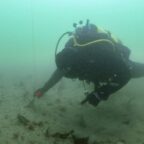
Seagrasses grow along coastlines nearly everywhere around the world, and they can store twice as much carbon in a given area as temperate and tropical forests. They provide food and shelter for fish, shellfish and sea turtles. They also blunt the impacts of ocean acidification, reduce coastal erosion and keep the water clean by filtering out excessive nutrients.
But the more than 70 species of seagrasses are among the most poorly protected coastal habitats.
Seagrass meadows in many places are imperiled by coastal development, overfishing, runoff from farm waste, and the growing threat from climate change. They have declined roughly 7% annually since the 1990s, a peer-reviewed study found. That is on par with the declines of tropical rain forests and coral reefs.
It doesn’t have to be this way. The comeback of seagrass beds in New Hampshire’s Great Bay gives hope for recovery elsewhere.
Peering over the side of his skiff, Fred Short liked what he saw.
Just below the surface, the 69-year-old marine ecologist noticed beds of bright green seagrass swaying in the waist-deep water. It was the latest sign that these plants with ribbon-like strands, which had declined up to 80% since the 1990s, were starting to bounce back with improved water quality. Seven rivers carry pollution from 52 communities in New Hampshire and Maine into the 1,020-square-mile bay.
“It actually looks better than it did last year at this time and better than has in many years,” said Short, a noted seagrass expert who coordinates the monitoring of 135 sites around the world from his University of New Hampshire lab.
“You see here,” he said, glancing into the water. “It’s nearly 100% cover. You look to the bottom. You can’t see the mud. You just see eelgrass. That is as dense as it gets. That’s a really good sign.”
Seagrasses, which cover less than 0.2% of the world’s oceans, store twice as much carbon in a given area as temperate and tropical forests, a study by the United Nations-affiliated Blue Carbon Initiative found.
Some seagrass declines have occurred with stunning speed. Central California’s scenic Morro Bay has lost more than 90% of its eelgrass since 2007.
“It’s certainly not a pretty picture and may not get any prettier because of the climate change issues we are all dealing with,” said Virginia Institute of Marine Science’s Robert Orth, a professor who has studied seagrass for decades. “These plants are very sensitive to environmental characteristics — water quality, temperature.”
In parts of the United States and other developed countries, there is growing recognition of the importance of seagrass and its sensitivity to nitrogen-rich runoff from sewage treatment plants and other sources. Too much nitrogen can spike algae growth, which clouds the water and blocks the sunlight seagrass needs to grow.
“We think this is a problem that has to be solved,” said Ken Moraff, water division director for U.S. Environmental Protection Agency’s New England region. Communities around the Great Bay have spent about $200 million to upgrade wastewater treatment plants, resulting in some cutting nitrogen releases by up to 70%, according to EPA and officials in several Great Bay communities.
“We’ve seen other areas where reductions in nitrogen do result in the ecosystem starting to come back,” Moraff said.
Studies have documented seagrass recovery in Boston, Tampa Bay and Long Island Sound.
Boston Harbor was once known as the dirtiest harbor in America because most waste went into the waters untreated.
Then the state invested $3.8 billion in a treatment facility on Deer Island that was completed in 2001 and allowed wastewater to be piped almost 10 miles (16 kilometers) out into Massachusetts Bay. The state has documented an 80% decline in nitrogen levels in the harbor.
Tay Evans, a seagrass specialist with the Massachusetts Division of Marine Fisheries, said there has been a corresponding 50% increase in eelgrass from 2006 to 2016. Now seagrass is growing in Governors Island Flats near Logan International Airport.
“It was astounding me,” Evans said. “I dove there and saw what we would call a moonscape that was just mud. You come back and it’s a lush meadow and then you’re going to see all the animals — the winter flounder swimming through there, lobster walking around.”
In Tampa Bay, seagrass beds are reaching levels not seen since the 1950s.
More than $2.5 billion was spent on upgrades to sewage treatment plants, measures to address stormwater runoff and curbs on nitrogen emissions from power plants. That resulted in two-thirds less nitrogen going into the bay compared to the 1970s, according to Ed Sherwood, executive director of the Tampa Bay Estuary Program.
Seagrass area nearly doubled to about 63 square miles (163 square kilometers). The water quality improvement along with a gill net ban has contributed to the recovery of several fish species including striped mullet, red drum and spotted sea trout.
But such stories can’t mask the challenges.
Some recoveries such as those in parts of the Boston Harbor and the Great Bay are at risk from dredging. In other places, such as Chesapeake Bay, a decline in nitrogen has benefited many underwater plants but not eelgrass, which has declined since the 1990s.
Brooke Landry, a Maryland Department of Natural Resources biologist who monitors the bay’s underwater vegetation, said that eelgrass, a coldwater species, may be more susceptible to heat events as seen in 2005 and 2010 — or to overly cloudy waters in the bay.
Scientists are also struggling to understand why eelgrass hasn’t come back in California’s Morro Bay.
“We have some theories,” said Jennifer O’Leary, who studied the bay as a California Sea Grant researcher. She said the eelgrass decline has occurred in waters that are warmer, saltier, cloudier and less oxygenated than the bay’s mouth, where eelgrass did well.
In New Hampshire, eelgrass has recovered about 20% in parts of the Great Bay, though it hasn’t returned to several areas.
Some conservationists argue that bayside communities need to further reduce nitrogen releases through tens of millions of dollars in treatment plant improvements.
But several towns counter they have already made significant upgrades to their plants and that they should focus on cheaper options.
“You want to put your money where it’s going to do the most good,” said Portsmouth Deputy City Attorney Suzanne Woodland.
The EPA is considering allowing communities to hold off on treatment plant upgrades while they try to reduce nitrogen from stormwater runoff and septic tanks. Some communities upgraded sewage treatment voluntarily while others made upgrades to settle EPA enforcement actions.
Walking to his lab with his latest seagrass samples, University of New Hampshire’s Short says that approach allows communities to avoid the painful steps necessary to ensure full recovery.
“It’s easier to say no, no let the next guy pay for it,” he said. “But now we are at the point where it’s causing a huge issue. You don’t have to believe the science. Go out there and look.”















Social Profiles